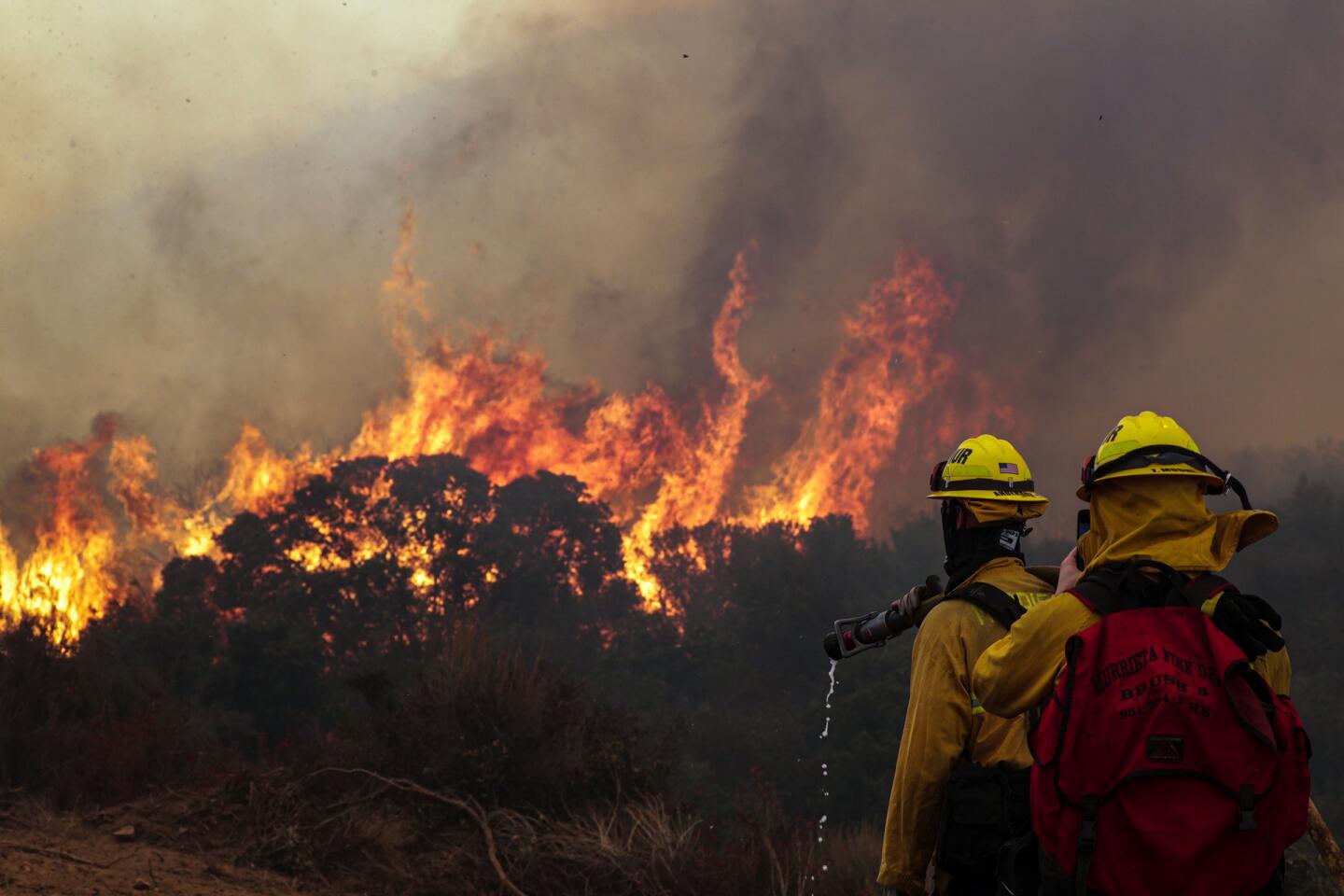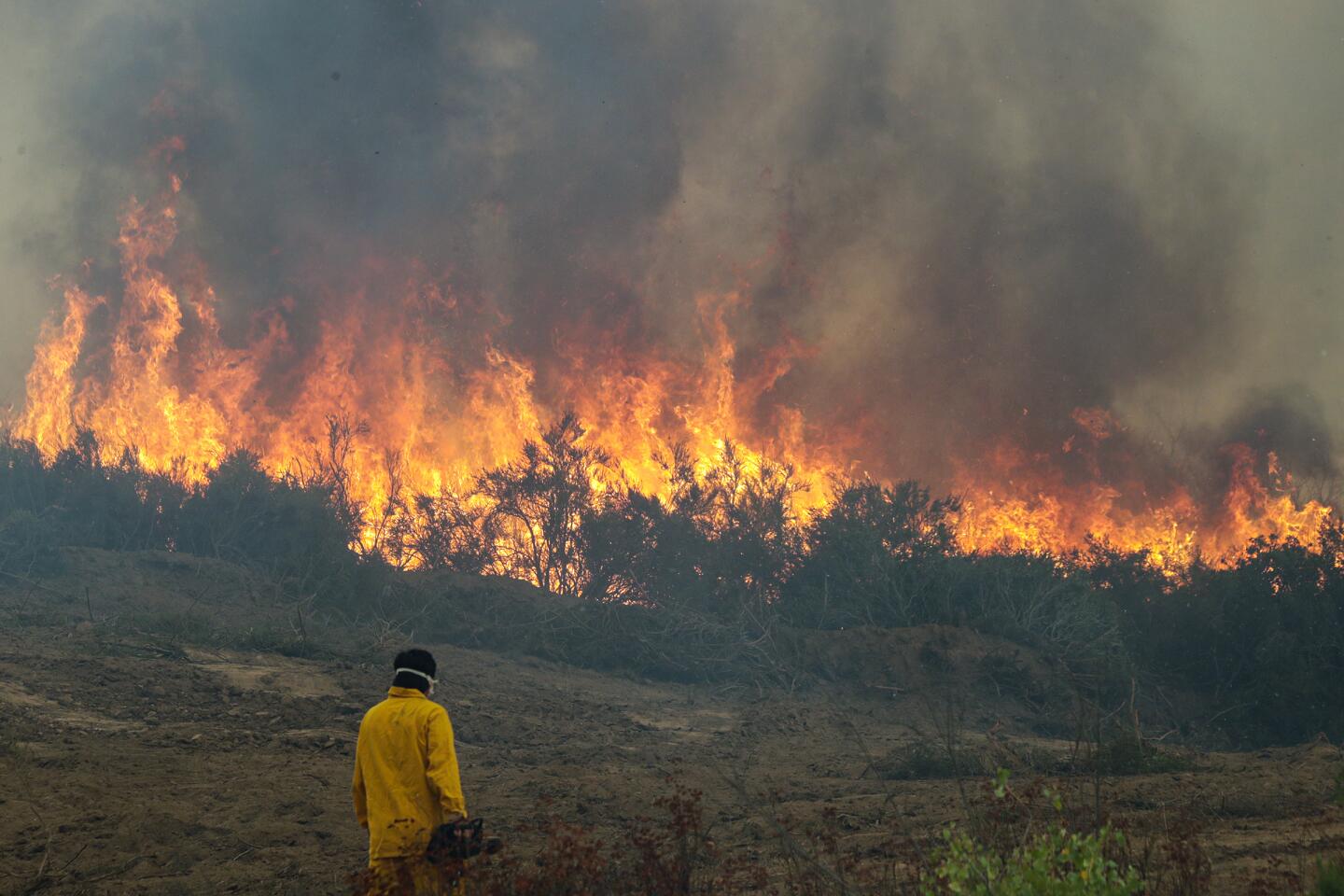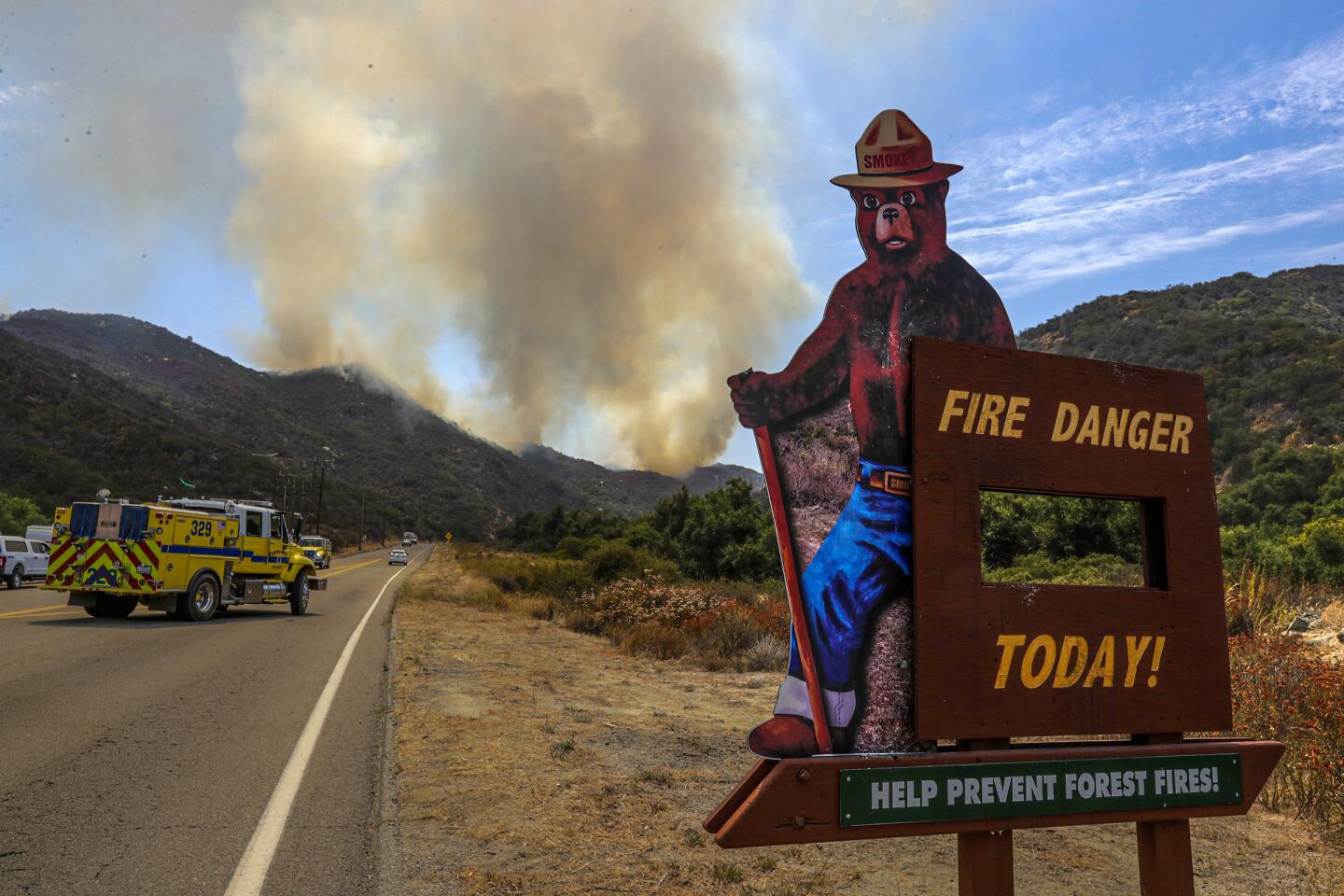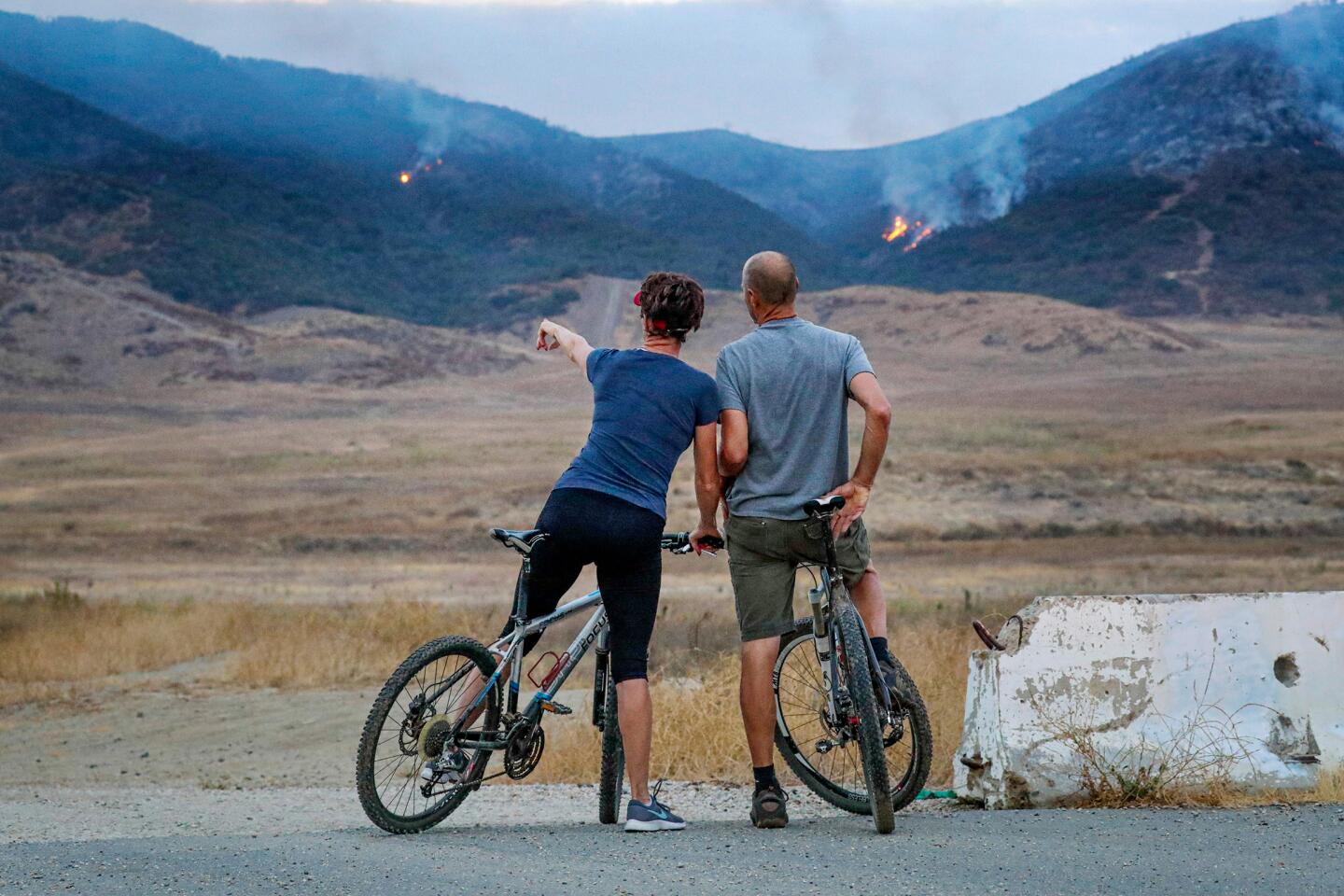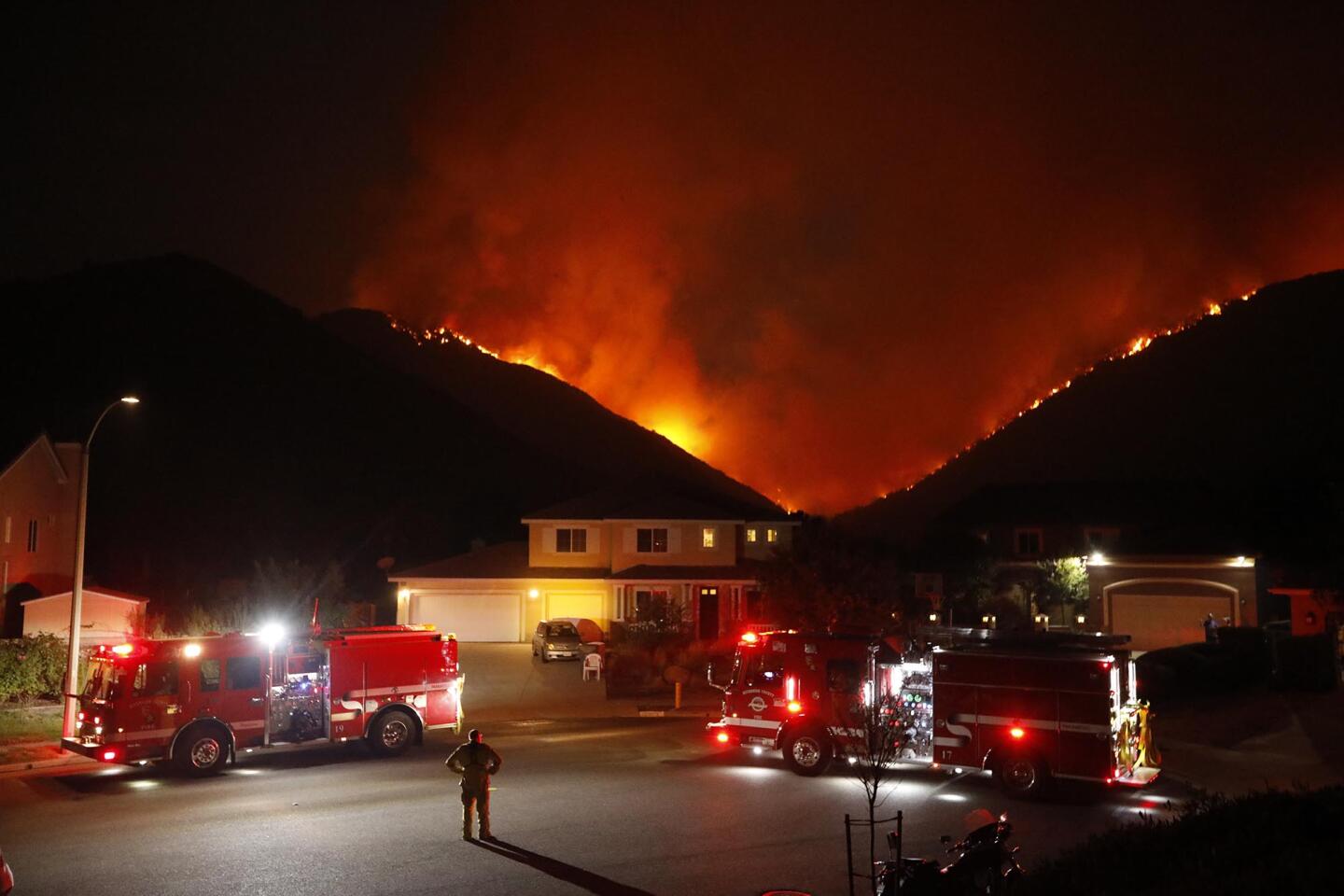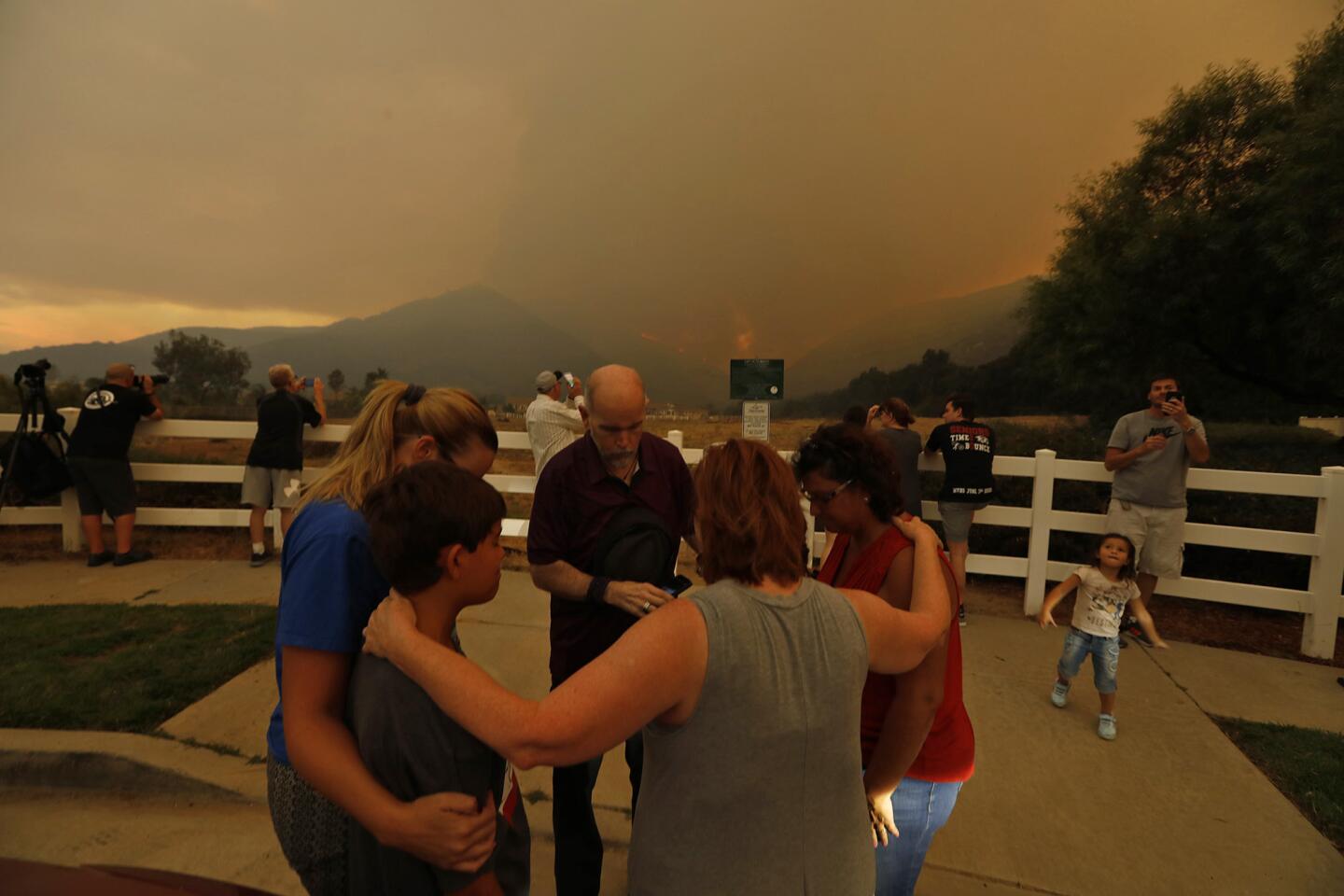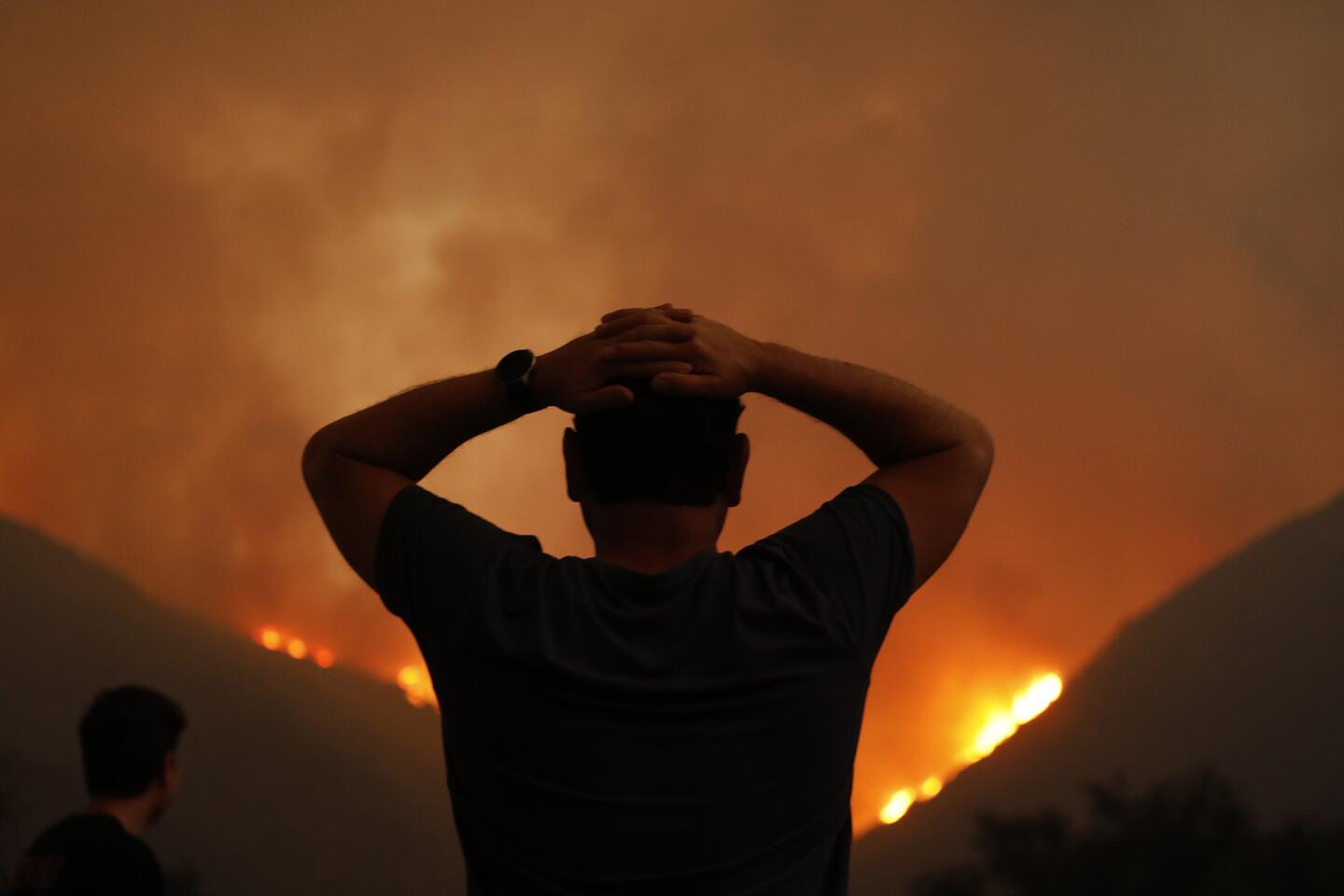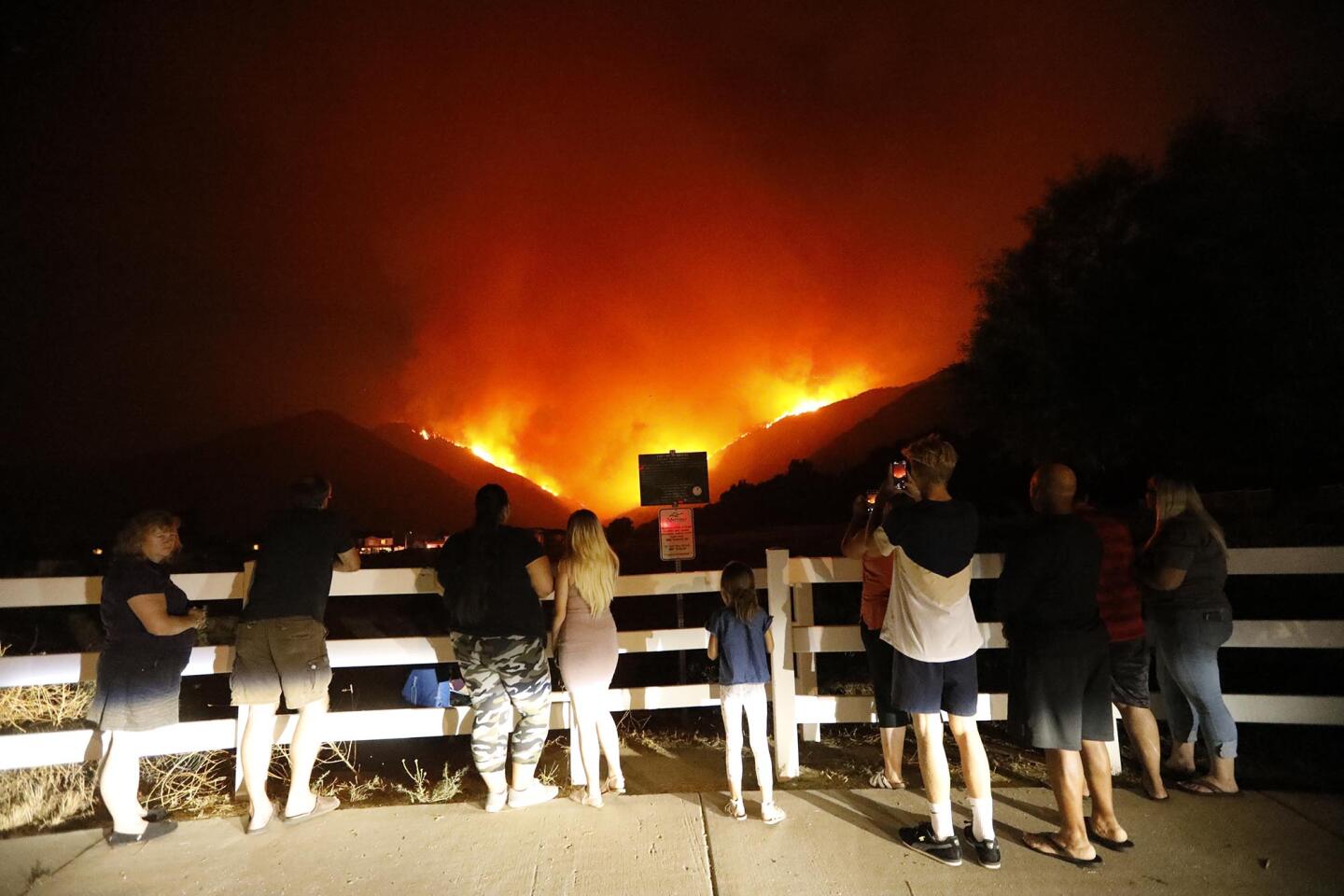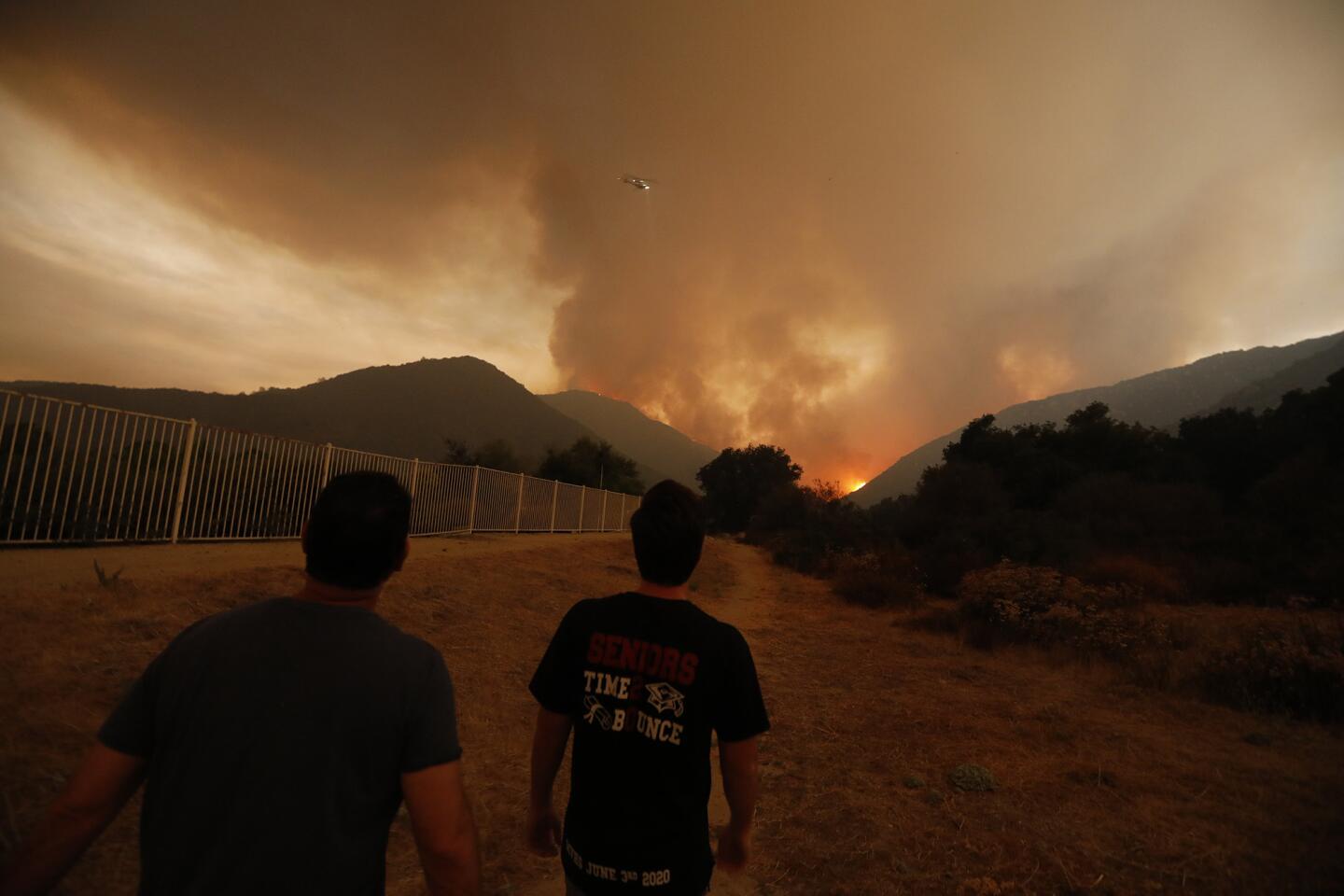Tenaja fire near Murrieta grows to 1,974 acres as evacuations remain in place

- Share via
A fast-moving brush fire that erupted in the hillsides near Murrieta grew to 1,974 acres Thursday and prompted new evacuation orders for more neighborhoods in the city of about 113,000.
More than 500 firefighters have been assigned to the Tenaja fire in Riverside County, which was at 10% containment as of 6 p.m. Thursday.
The fire started about 4 p.m. Wednesday near Tenaja and Clinton Keith roads on a day marked by thunderstorms in the region. It burned all the way down to the Copper Canyon neighborhood in Murrieta overnight, but crews stopped the flames before any homes were damaged, said Capt. Fernando Herrera, a spokesman for the California Department of Forestry and Fire Protection.
“The fire probably came within a couple thousand feet of homes,” he said.
Two structures received a small amount of cosmetic damage, he said. No injuries have been reported, and the cause of the fire has not been determined.
Humid conditions and water dropped from helicopters allowed firefighters to gain the upper hand overnight into Thursday morning. While helicopters fought the fire from the sky, crews cut fire breaks ahead of the blaze in an effort to slow its movement.
“That gave us a huge advantage,” Herrera said of the helicopter’s efforts overnight. “We were successful in at least knocking down the heavy flames and heat. The fire is laying down right now.”
Firefighters had reached 7% containment by early Thursday, but then that afternoon, gusting winds pushed the fire across the breaks and sent it racing down the ridge.
The flames burned up to a creek area at the base of the Copper Canyon development and again threatened homes, but firefighters were able to beat them back, Herrera said.
Shortly after 2 p.m., officials issued new evacuation orders for homes along Montanya, Botanica and Belcara places and Lone Oak Way in Murietta. Officials had previously ordered evacuations of houses along the Trails Circle in La Cresta and Copper Canyon, as well as the Santa Rosa Plateau visitor center on Clinton Keith Road. Evacuations were still in place Thursday night for more than 400 homes in the area.
Flames also surrounded a Murrieta Fire Department station in the Copper Canyon area. Crews used a bulldozer to cut a line in the vegetation around the station. They were able to save the building and the department’s equipment, Herrera said.
By about 2:30 p.m., the flames along the fire’s southeastern flank had died down, he said.
“It’s consumed most of the dry field in its path,” he said of the fire. “So right now, the conditions on this side are extremely smoky. There’s a lot of overhaul to do, but most of the fuel has been consumed.”
Firefighters, however, were faced with erratic winds gusting up to 30 mph and temperatures reaching into the 90s. The heat could further dry out dense grass and brush in the region, priming it for burning, said Jimmy Taeger, a meteorologist with the National Weather Service in San Diego.
Showers and thunderstorms in the mountain areas also raised the possibility of dry lightning strikes through Thursday evening, Herrera said.
Officials hoped that winds would blow up the slope overnight and continue to push the fire back toward vegetation that had already burned. But Herrera cautioned that the volatility of the weather conditions made the fire’s behavior hard to predict.
“As long as that weather pattern remains it means there’s potential for the fire to blow up again and gather some speed,” he said.
The National Weather Service on Thursday afternoon tweeted satellite imagery showing the developing thunderstorms and the heat signature of the fire. By about 1 p.m., the fire had begun to generate pyrocumulus clouds.
“Oftentimes, when a fire is really intense and the environmental conditions are favorable enough, you’ll get essentially clouds forming right where the plume rises,” said Bruno Rodriguez, a meteorologist with the National Weather Service in San Diego. “Typically we’ll see it on larger fires where the burning is more intense because you have more heat production, and therefore the increased heat production results in a stronger updraft to raise that plume higher and make it more likely to develop into a cloud at higher altitudes.”
On both Wednesday and Thursday, the fire was most active in the midafternoon. Forecasters and fire officials said the same could happen Friday as it was expected to be another hot, somewhat dry day, with humidity at about 30% and gusts up to 15 mph in the late morning and afternoon.
“We’ll take advantage of nightfall,” Herrera said Thursday. “This evening, we’ll be able to get our folks up on the higher ridges to work that and just continue strengthening the perimeter of the fire, making sure we put out any hotspots on the perimeter so we have that in effect tomorrow.”
Four helicopters and least four air tankers have been assigned to drop water and fire retardant in the area. Rugged terrain continues to be a challenge for crews on the ground, meaning officials will be relying heavily on air resources, Herrera said.
In just a few hours on Wednesday, the fire chewed through nearly 1,000 acres in unincorporated Riverside County and began its trek northeast toward Murrieta.
Residents of Murrieta’s Bear Creek community are under voluntary evacuation. Campuses in the Murrieta Valley Unified School District were closed Thursday because of the fire.
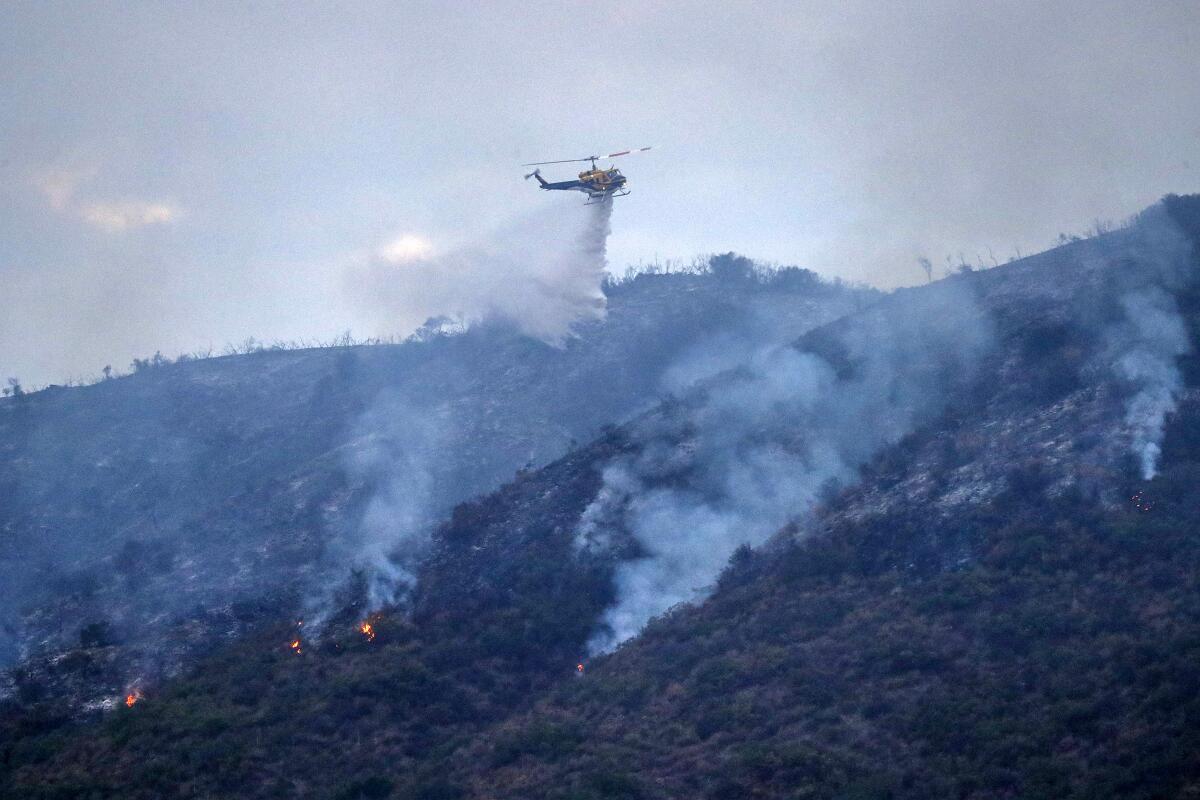
The blaze erupted toward the end of a remarkably calm summer in terms of wildfires.
After two years of devastating wildfires that burned more than 1.8 million acres in 2018 and 1.2 million acres in 2017, as of Aug. 18, only 51,079 acres had burned this year across state and federal lands in California.
Late spring rains, cooler summer temperatures and fewer extreme wind events, among other factors, have combined to help keep the state from burning uncontrollably, experts say.
But weary fire officials know that can change at any moment — all it takes is an intense wind event or a prolonged heat wave and then a spark.
In the Murrieta area, ash fell like snow as police patrol cars with lights flashing cruised slowly through neighborhoods to announce evacuations Wednesday evening. The blaze cast an orange glow on the hillsides above homes.
Beth Maranville, 59, of Murrieta was standing near a ridge in Oakhurst Estates watching the fire grow closer to homes. Maranville had watched the fire when it was farther away near La Cresta and was shocked at how quickly it had burned through brush.
About 8 p.m., law enforcement officers came through the area and asked Maranville and others to voluntarily evacuate, she said.
“I just saw the lights go out from the house that’s closest,” Maranville said. “They had already wet their house down. It’s not looking good, but we’ve prayed, and we’re going to trust God.”
More to Read
Sign up for Essential California
The most important California stories and recommendations in your inbox every morning.
You may occasionally receive promotional content from the Los Angeles Times.


